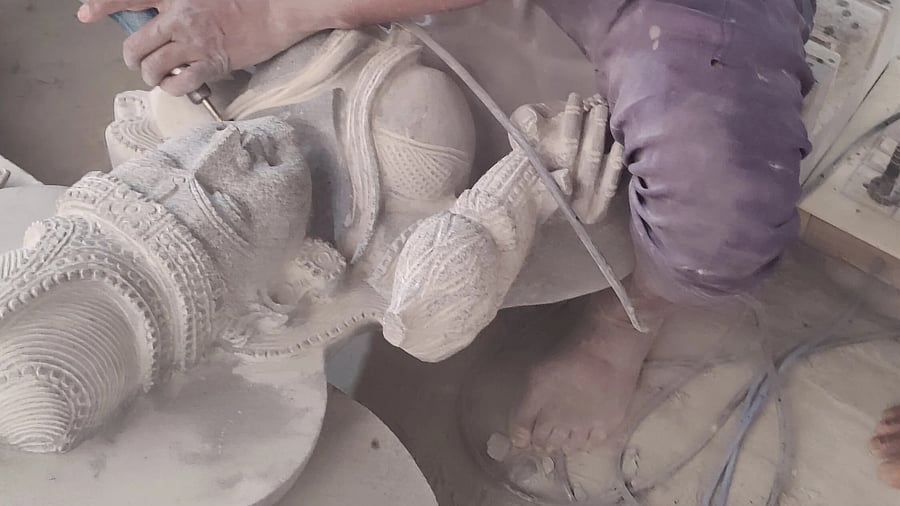
A sculptor at work at Shivarapatna in Kolar district.
Credit: Niranjana Vanalli
On the Bengaluru–Tirupati highway, just past the Narasapura industrial area in Kolar district, is Shivarapatna, famed for its stone-carving tradition. The village has a little over 400 houses and around 120 of them are engaged in stone sculpting. These artisans have continued the hereditary vocation passed down from their forefathers.
According to local lore, Shivarapatna’s stone-carving tradition goes back a thousand years to the Ganga dynasty. Some artisans believe they are descendants of the sculptors who built the famed temples of Belur.
“Earlier, only people from the Vishwakarma community took up idol-making. Now, artisans from many communities have been trained and are practising the craft,” says Jagannatha Acharya, a seventh-generation sculptor.
Traditionally, the sculptors carved idols of Hanuman, Ganesha, Vishnu and other deities, strictly adhering to the needs of temple patrons. Today, with survival becoming more complex, the artisans sculpt a variety of stone idols including the busts of national icons. They also make idols in panchaloha, an alloy of five metals. Carving a three feet idol typically takes a sculptor at least one-and-a-half months, though the time can extend depending on the intricacy of the design. Most works are made on order, with demand for divine idols coming largely from Karnataka and neighbouring states.
Idol crafting
The process begins with choosing a suitable stone. Subsequently, the stone block is cut into smaller pieces and the design is sketched onto its surface.
“We carve divine idols strictly according to the time-tested Shilpa Sutras, which lay down the measurements, proportions, composition and other guiding principles,” explains sculptor Nandakumar.
A rough form is first chiselled out using traditional tools, with some machine assistance. Slowly, the finer details emerge. The sculpture is then smoothened and the finishing touches are done entirely by hand. The eyes, the defining element of the idol, are carved only after the idol is installed in the temple.
Stones from faraway hills
However, the stones that sustain Shivarapatna’s craft are not local. Raw blocks arrive from the quarries of Chamarajanagar or the rocky hills of Chitradurga.
“Earlier, we used to source stone from Surya Malleshwara Betta near Vemgal, around 20 km from Shivarapatna. Now, the stone remains only atop the hillock and is hard to bring down. There are also forest department restrictions,” says Jagannatha Acharya.
They source balapa kallu, a soft grey stone ideal for detailed sculpting, from Chamarajanagar. Krishnashila, a harder black stone that rings like iron when struck, is sourced from Chitradurga.
Sculptors take quarry contracts in both regions. One tonne of larger stone costs around Rs 15,000 and transportation costs around Rs 5,000. “Woodcarvers receive timber from government depots at subsidised rates. But we receive no such support despite repeated appeals to successive governments,” several artisans lament.
They explain that even after procuring stone from another town or district, there is no guarantee it can be used for sculpting. The garbha, a weak patch within the stone, sometimes becomes visible only after carving begins. Such stones cannot be used and the labour and money invested until that point are simply lost.
According to Jagannatha Acharya, they can make only two idols, each about three to three-and-a-half feet tall, from a tonne of stone, as nearly 50% is lost during chiselling. These idols fetch between Rs 50,000 and Rs 75,000 each. The price depends on the sculptor’s skill and the level of detailing, but many sell their work for less due to competition. The number of idols per tonne decreases even further when the designs are more intricate. At present, a highly skilled sculptor earns around Rs 5 lakh to Rs 6 lakh annually, including the wages paid to assistants.
Another threat now looms over the village. For decades, Shivarapatna’s artisans have worked from makeshift sheds on the outskirts, as the dust makes carving indoors impossible. But the Karnataka Industrial Areas Development Board has begun acquiring land on the village periphery for industrial projects.
In a village where stone carving has flourished for centuries, there is suddenly no space left for the craft.
Youth continue
While many ancient crafts are fading due to a lack of interest in the younger generation, Shivarapatna stands apart. The younger generation here is not abandoning stone carving. They are willing to embrace the uncertainties of the craft and forge a livelihood from it. All they ask for is necessary support that acknowledges their art and enables them to thrive.
For now, Shivarapatna continues to echo with the music of chisel and hammer. But the question hangs in the dust-laden air: will this sound endure?